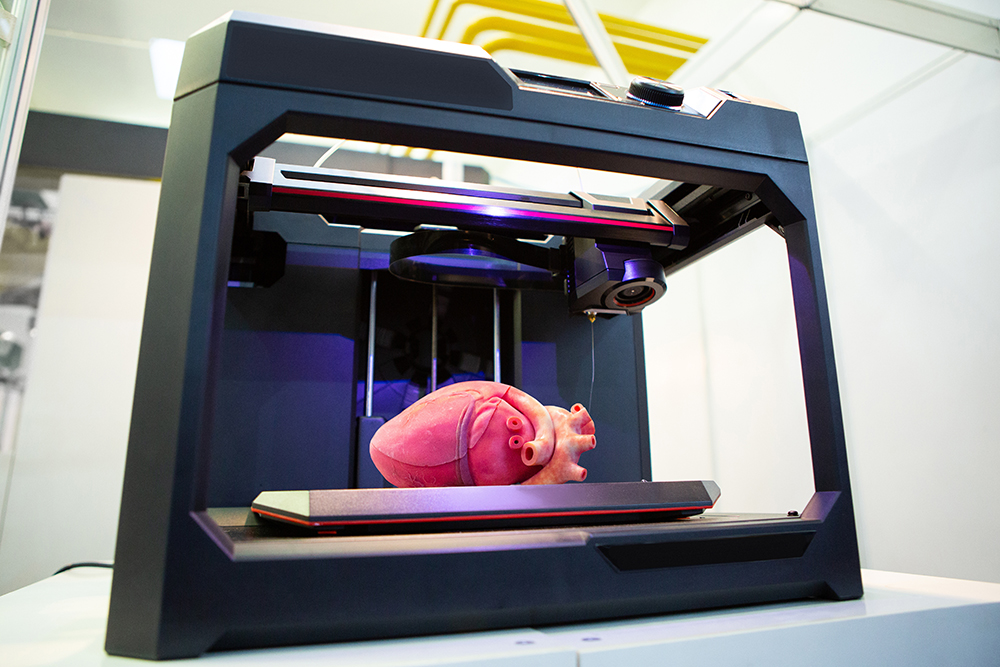Biomechanics and Biomaterials involves the kinematics and kinetics relevant to human anatomy, such as human motion, including linear, angular, and nonlinear analyses, and fluid mechanics relating to human physiology (e.g. blood flow, air flow), including flow, resistance, and turbulence. Stresses and strains in biological tissues, determined experimentally or with computer simulations, help to understand relationships between structure, function, remodeling, and degradation of the tissues. Such analyses are important in diagnostics (e.g., gait analysis, fracture prediction) and for device evaluation (e.g. heart valve design or repair, implant performance prediction). Topics also include the design of prosthetic/orthotic devices and implants or the design of intelligent and robotic biomedical assistive and rehabilitation devices. Research is conducted in areas concerning mechanics, biocompatibility and bioactivity of material, human and tissue interaction with engineered devices, biorobotics, and control theory as applied to biomedical and assistive devices.
For Professors working in this area, refer to the Faculty list (Biomechanics and Biomaterials)
COURSES:
BIOM 5300 (BMG 5300)
Biological and Engineering Materials
Properties of structural biological materials (bone, tendon, ligament, skin, cartilage, muscle, and blood vessels) from an engineering materials viewpoint. Selection of engineering materials as biomaterials. Introduction to biocompatibility. Histology of soft tissues. Viscoelasticity, mechanical properties and models of muscles, ligaments and tendons. Co-requisite: BIOM 5100/BMG 5100.
BIOM 5301 (BMG 5301)
Biomechanics of Skeletal System, Motion and Tissue
Analysis of human motion. Kinematics and kinetics of various activities. Engineering analysis and modeling techniques applied to human motion. Injury mechanics, treatment, prosthetic replacements. Fracture behaviour and healing processes.
BIOM 5302 (BMG 5302)
Biofluid Mechanics
Properties of blood. Blood flow models for vessels, circulation systems and the heart. Man-made blood vessels. Kidney flow and exchange. Modeling of perfused tissues and cells. Transport phenomena across membranes. Molecular and ionic transport. Other body fluids.
BIOM 5303 (BMG 5303)
Ergonomics and Design
Review of ergonomic issues encountered in engineering design, including biomechanical, physical and physiological issues. Strategies for human interaction with complex systems, such as aircraft cockpits, equipment control consoles, human-robotic interactions, and tele-operated equipment.
BIOM 5304 (BMG 5340)
Advanced Topics in Biomechanics and Biomaterials
Recent and advanced topics in the field of biomechanics and biomaterials and its related areas.
BIOM 5306 (BMG 5306)
Special Topics in Mechanical & Aerospace Engineering: Biomechanics
Overview of human anatomy and physiology with emphasis on artificial organ and prosthetic device design requirement. Application of engineering principles to cells and tissues, biofluid mechanics, human body energetics, measurement techniques, mechanics of human body systems, with emphasis on the artificial heart. Also listed as MECH 5801 (MCG 5489I). Offered at the undergraduate level, with different requirements, as MAAE 4906, for which additional credit is precluded.
BIOM 5311 (BMG 5311)
Design of Medical Devices and Implants
Solutions to clinical problems through the use of implants and medical devices. Pathology of organ failure and bioengineering and clinical aspects of artificial organs. Examples: blood substitutes, oxygenators, cardiac support, vascular substitutes, pacemakers, ventricular assist devices, artificial hearts and heart valves.
BIOM 5312 (BMG 5312)
Design of Orthopaedic Implants and Prostheses
Anatomy of the musculo-skeletal system. Electromyography. Static and dynamic analysis of the human skeleton. Materials and manufacturing considerations for orthopaedic devices. Strength and failure theories. Implant fatigue, fracture and corrosion.
BIOM 5314 (BMG 5314)
Biocontrols
Application of traditional control system principles to the human body. Functionality of sample actuators and sensors. Characterization of human body control loops with emphasis on system stability, robustness, and effect of adverse external disturbance.
BIOM 5315 (BMG 5315)
Biorobotics
Interpretation of physical laws as applied to human motion, kinematics and dynamics of humanoid robots, modeling of biological sensors and actuators, artificial muscles, tele-manipulation, robot assisted surgery, and multi-fingered end-effectors. Design of mechatronic devices including rehabilitators, extenders, haptic devices, and minimally invasive surgery systems.
BIOM 5316 (BMG 5316)
Biotransport Processes
Application of chemical engineering principles to medicine and biology. Principles of mass transfer and fluid dynamics in topics such as hemodialysis, artificial kidney, diffusion in blood, mass transfer in the eye, drug distribution in the body, and advanced life support systems.
BIOM 5323 (BMG 5323)
Rehabilitation Engineering
Multidisciplinary approach to assistive-device design. Biomechanics applied to rehabilitation. Gait, neurological disorders, pathological gait, prosthetics, orthotics, seating, and mobility. Transducers, bio-instrumentation, EMG, FES. Augmentive communication and sensory aids. Human-assistive device interfaces, human-robot interfaces, computer-vision-guided rehabilitation aids, telerehabilitation.
BIOM 5330 (BMG 5330)
Electromagnetic Fields and Biological Systems
Review of Electromagnetic waves at radio and microwave frequencies. Electrical and magnetic properties of tissue. Impact of electromagnetic waves on tissue. Cellular effects.
